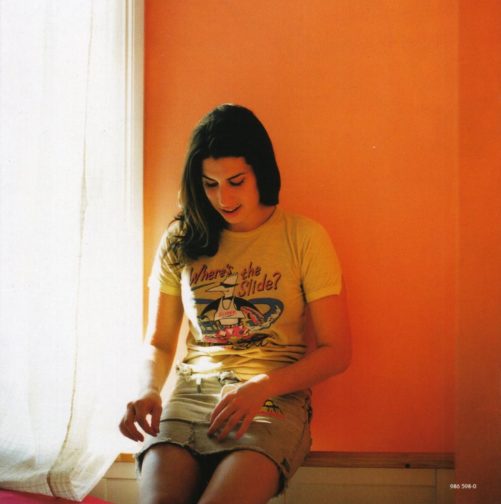
Yesterday I visited Amy: Beyond the Stage, the Design Museum in London’s eclectic tribute to Amy Winehouse. Amy is my favourite artist of all time; she was my number one listened-to artist on Spotify last year, and He Can Only Hold Her was my most streamed song. So, as you can imagine, I had high expectations for this celebration of her life and musical career. The intimacy constructed by the exhibition between viewer and Amy’s dresses, interviews and music did not disappoint.
From the moment you descend the narrow white stairwell into the exhibition, you are immediately transported into the world that was Amy’s. Pages from her childhood notebooks are pinned to the wall as you enter the first room; her jotted poems and shopping-lists speak of the charm and wit she had as a child and flourished in her public presence in the early years of her career. In the next room, a great screen plays videos of some of her best moments on stage as you read her hand-written lyrics and pick up headsets to listen to her in interview or in the recording studio. These deeply personal moments are punctuated by mannequins wearing her playful ensembles, with pieces from noughties high-street labels like Dorothy Perkins and Karen Millen that made her both charismatic and relatable to her fans. These mannequins, while scaled to her petit frame, are almost unable to capture how her clothes worked with her: sculpting not only to her figure, but also her spirited personality. After all, she was never an artist who required costuming to forge her on-stage presence: the clothes never outshone her, but became an indelible part of her iconic appearance.
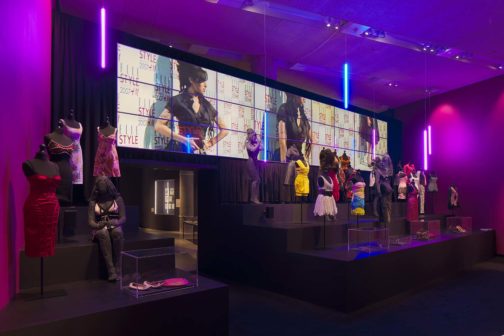
Some of the most affecting moments of the exhibition occur not in the audio experiences, but in the small labels beside each exhibit. Each one describes the item next to it, whether it be her baby-pink retro Roberts radio or a pair of Dolce & Gabbana stilettos, with a reverse-embossed lyric and love hearts in Amy’s handwriting. The detail is ghostly but touching, permeating each object with her inimitable character. Anecdotes from her stylist, Naomi Parry, are testament to the significance of fashion in Amy’s life and career. One label reads: ‘we found a style that she was really comfortable with, and it became synonymous with her. It was like her armour – she put that on and she became Amy Winehouse.’ Accordingly, the third room of the exhibition, with a tiered stage of mannequins wearing her classic rockabilly styles, literally presents us with an army of Amy’s. Small glass cases on the lowest tier contain some of her accessories, many of them thrifted in Camden market. On the wall facing these mannequins is an exploration of her emblematic beehive hairstyle, and its 1950s girl-group influences, with a poignant label quoting Amy: ‘The more insecure I feel, the bigger my beehive gets.’ What prevails here however is a joyful celebration of her style, each piece imbued with a memory from her electrifying rise to stardom.
The only thing I wished for in the exhibition was more film and photographic documentation of Amy wearing these specific pieces, seeing as so many of them were worn at significant moments in her career. Here are just three of my personal favourite outfits showcased in the exhibition, worn by Amy herself:

This red Adidas zip-up dress appears in the section of the exhibition dedicated to her first studio album, Frank (2003). Amy wore the dress at several performances to promote the release of the album. The loose-fit lycra dress is elevated from being mere sportswear with the addition of a black lace bra that peaks through the drawn zip, giving her a sultry appearance to match the jazzy R&B aura of the album. Here she is as she takes the stage at an HMV store in Birmingham, beaming to the crowd before her. With her ‘Sonic Blue’ Fender Stratocaster guitar in hand (which is also in the exhibition), the sporty dress shows Amy ready for action as her career takes off.
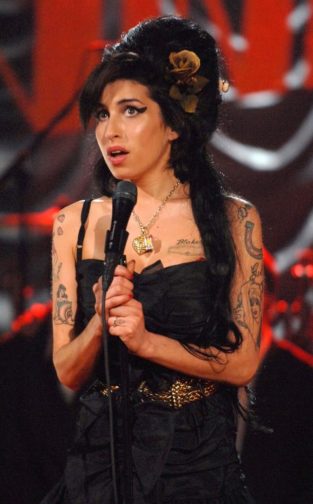
This black Dolce & Gabbana mini dress is seen on the stage of mannequins in the exhibition’s room dedicated to her style, and was worn in possibly my favourite Amy moment. Amy donned the dress in 2008 as she was awarded ‘Record of the Year’ for the track Rehab, from her second studio album Back to Black (2006). The camera pans to Amy as Tony Bennett reads out her name as winner, and at first she seems oblivious to the announcement. Realisation suddenly dawns on her and she gazes up to the screen in disbelief, members of her band rushing to her side to celebrate their win. They embrace her in a group-hug so that all we can see of her is the flowers pinned into the back of her beehive. As she musters an unexpected acceptance speech, she proudly declares: ‘This is for London, ‘cause Camden town ain’t burning down!’
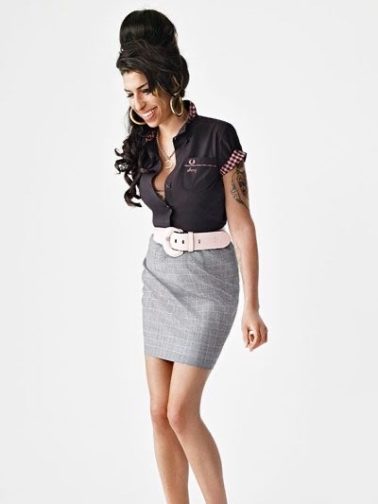
To the far-right of the stage, a few mannequins down from the Grammy dress, is an assemblage of some of the pieces created in a co-designed collection between Amy and Fred Perry. She regularly wore Fred Perry clothing off-stage, a brand which has proclaimed itself as ‘a badge of honour for just about every music-led subculture from ska to hip hop’, and also emerged as a staple in British streetwear in the 1950s. The collaboration was thus a perfect homage to Amy’s style: merging her rockabilly influences with her unrelenting dedication and love for London. While the ensemble shown here is not a direct match of the skirt and polo-shirt outfit in the exhibition, I think the elation Amy found in her style is captured perfectly in this instance. Her iconic silhouette – her waist cinched in with a characteristically large belt and her towering beehive – draws attention to her face as she laughs during the shoot.
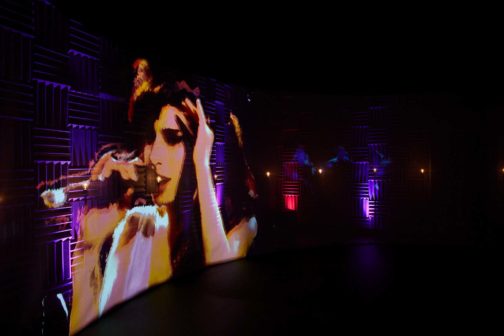
For me, the most poignant moment of Amy: Beyond the Stage occurs at the very end of the exhibition. In a small curtained-off room, a performance of Amy singing Tears Dry on Their Own is projected onto a translucent screen as the music floods the compact space. The projection is like a painting in motion, its brightly coloured brushstrokes capturing Amy for a fleeting moment before they dissolve and reconfigure elsewhere on the screen. As the music fades, the projected curtains close on the screen, marking the end of the exhibition with a moving silence. Despite the absence of Amy Winehouse today, what is left is the feeling that the legacy of her music and her dynamic character will endure long into the future.
Amy: Beyond the Stage is open until 10 April 2022. Tickets can be purchased following this link: https://designmuseum.org/exhibitions/amy-beyond-the-stage
Here is a link to the Amy Winehouse Foundation, a charity established in Amy’s memory ‘to inspire children and young people to build their self-esteem and resilience, so they can flourish’: https://amywinehousefoundation.org
By Erin-Atlanta Argun
Sources:
https://www.juliensauctions.com/auctions/2021/Amy_Winehouse/Amy_Winehouse_Flipping_Book/69/
https://www.instyle.com/news/amy-winehouse-stylist-recalls-working-late-singer
https://thamesandhudson.com/news/behind-the-scenes-of-amy-winehouse-beyond-black/
https://www.youtube.com/watch?v=x0q3Re5ksVg
https://www.glamour.com/story/amy-winehouse-for-fred-perry-l
https://www.fredperry.com/subculture/articles/amy-beyond-the-stage

